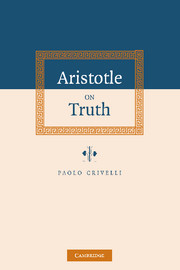Book contents
- Frontmatter
- Contents
- Acknowledgements
- Notes on the text
- List of abbreviations of titles of Aristotle's works
- Introduction
- Part I BEARERS OF TRUTH OR FALSEHOOD
- Part II ‘EMPTY’ TERMS
- Part III TRUTH AND TIME
- Appendix 1 Metaph. Θ 10, 1051b1: the text
- Appendix 2 Metaph. Θ 10, 1051b2–3: the text
- Appendix 3 Int. 7, 17b16–18: the text
- Appendix 4 The two-place relations in Aristotle's definition of truth
- Appendix 5 Aristotle's theory of truth for predicative assertions: formal presentation
- Appendix 6 The failure of bivalence for future-tense assertions: formal presentation
- References
- Index of names
- Index of subjects
- Index of passages
Appendix 1 - Metaph. Θ 10, 1051b1: the text
Published online by Cambridge University Press: 22 September 2009
- Frontmatter
- Contents
- Acknowledgements
- Notes on the text
- List of abbreviations of titles of Aristotle's works
- Introduction
- Part I BEARERS OF TRUTH OR FALSEHOOD
- Part II ‘EMPTY’ TERMS
- Part III TRUTH AND TIME
- Appendix 1 Metaph. Θ 10, 1051b1: the text
- Appendix 2 Metaph. Θ 10, 1051b2–3: the text
- Appendix 3 Int. 7, 17b16–18: the text
- Appendix 4 The two-place relations in Aristotle's definition of truth
- Appendix 5 Aristotle's theory of truth for predicative assertions: formal presentation
- Appendix 6 The failure of bivalence for future-tense assertions: formal presentation
- References
- Index of names
- Index of subjects
- Index of passages
Summary
The evidence. At 1051b1 the main witnesses present a variety of readings: Ab and (probably) ps.-Alexander (in Metaph. 598, 1–2) have ‘κυριώταταὂν’; the first hand of E has ‘κυριώτατον εἰ’; J and the second hand of E have ‘κυριώταταεἰ’; William of Moerbeke's translation presupposes ‘κυριώτατα ἢ’.
Brandis, Bekker, Weise, Schwegler, Bonitz, Dübner, Christ, and Jaeger print ‘κυριώτατα ὂν’. Ross (followed by Tredennick and various commentators) excises ‘κυριώτατα ὂν’ (he also contemplates the possibility of transposing it after ‘τὸ μὲν’ at 1051a34). Jaeger suspects a lacuna between ‘κυριώτατα ὂν’ and ἀληθὲς ἢ ψεῦδος’: he suggests ‘κυριώτατα ὂν <ἡ οὐσία, λείπεται δὲ ἐπισκοπεῖν τὸ ὂν> ἀληθὲς ἢ ψεῦδος’.
An inconsistency? Many editors and commentators find the reading ‘κυριώτατα ὂν’ of Ab at 1051b1 hard to accept because in Metaphysics E 4 (= T7), at 1027b31, Aristotle says that what ‘is’ in the sense of being true ‘is a different thing that “is” from the things that “are” in the strict sense [κυρίως]’: were the reading ‘κυριώτατα ὂν’ genuine, in Metaphysics Θ 10 Aristotle would be committing himself to the incompatible claim that what ‘is’ in the sense of being true is what ‘is’ in the strictest sense. The fact that E 4, at 1027b28–9, contains a forward reference to Θ 10 makes it particularly implausible to assume that Aristotle should entertain such incompatible views about what ‘is’ in the sense of being true.
- Type
- Chapter
- Information
- Aristotle on Truth , pp. 234 - 237Publisher: Cambridge University PressPrint publication year: 2004



